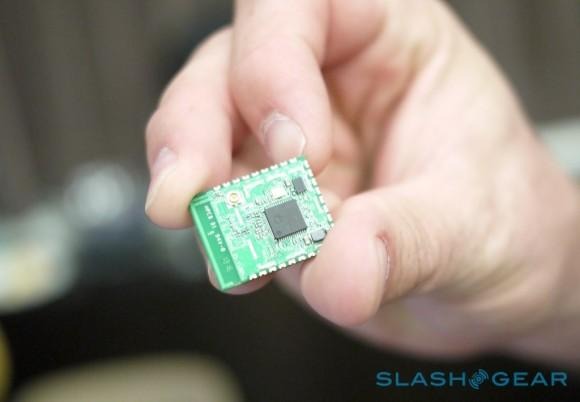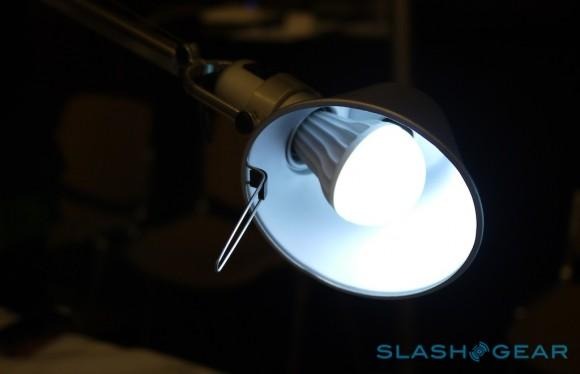Qualcomm's Wireless Bulb Wants To Outshine Hue With WiFi
Roll on the smart home: Qualcomm has an eye on being the glue that sticks wireless home automation together, and it's demonstrating that with some proof-of-concept remote control lightbulbs. Thanks to a tiny new Qualcomm Atheros chipset, the demo light hooks up via WiFi to a simple Android app which allows for remote on/off control, dimming, and even timed shutoff. It's an obvious stab at alternative lighting systems like Philips' hue, but Qualcomm won't be content with just the lamp market.
The demo bulb itself is a straightforward white example, only lighting up in a single color unlike hue's color-changing bulbs. It screws into a standard fitting and then, as long as the power is left switched on, all control over it is from the Android app.
Qualcomm's app isn't anywhere close to being the most attractive we've seen, nor indeed is it particularly advanced in its functionality. Still, it does the basics and gives an inkling of what the system could one day do: you can pick a bulb and then toggle its brightness through various different levels, as well as set timers to turn it off at a later point.
Inside the bulb, there's a new chipset from Qualcomm's QCA4002 and QCA4004 networking platforms. That SoC, about the size of a postage stamp, contains not only the WiFi radios but a CPU and memory, which means the light processing itself can actually be done within the bulb rather than demanding a separate box somewhere.

WiFi has traditionally struggled to gain traction as the interconnect between home automation devices, since it generally needs more power than rival standards such as ZigBee and Z-Wave. Not so much of an issue if you're hooking up a fixed appliance, like a fridge or a dryer, to the internet-of-things, but more problematic if you want something battery powered to last for more than a few days.
That's something Qualcomm has focused on with the QCA4002/QCA4004 platform, introducing dynamic power management that can adjust the output of the radios depending on the distance to the next device or access point. Qualcomm calls it Green TX, and claims it can cut the power requirement by up to half; meanwhile, more efficient sleep modes trim consumption down to under 1mW. It's managed by a dedicated wake-up manager running on the chip's processor, and which can wake the chipset from sleep mode four-times faster than rivals, which also things responsive.
The end result, Qualcomm tells us, is a chipset that can add wireless capabilities to a device and still run for up to a year on a pair of AA batteries.
Lighting isn't the end of it, though. The QCA4002/QCA4004 chips use Qualcomm's AllJoyn to talk with one another, the same technology that's used in the AllPlay streaming media system announced last week.
AllJoyn is Qualcomm's proposed glue for the internet of everything, with support for audio and video streaming (such as for a Sonos challenger), remote control, mesh networking, and more, with each individual device intended to be smart enough to get itself on the overall network without requiring complex setup. Qualcomm already has demo hardware using the QCA4002/QCA4004 chips in washing machines and air conditioners, with part of the work behind the SoCs being in how they use white goods industry standardized connectors to hook into the regular onboard control systems.

Where it starts to get really competitive is the price. To put a wireless chip from the new range into a bulb currently costs around $10, Qualcomm said; think on a larger scale, however, and you could bring that down to around the $5 mark. That means it works financially not only in terms of a big-ticket item like a washing machine, but down to individual bulbs, door locks, window security, and other smaller items. In contrast, each extra Philips hue bulb comes in at around $50.
The current smart home bloom lacks one single name that dominates it. Qualcomm doesn't want to necessarily be that name, the company tells us, but it would like AllJoyn to be the underlying technology that the big firms end up using. WiFi has some obvious advantages over the current alternatives, too, such as generally not requiring a standalone adapter to bright with a home network; most people are likely to have WiFi-enabled routers, Qualcomm assumes.
There's plenty still to be done. Qualcomm has to convince what's effectively a fledgling market dominated by smart home start-ups and old-school appliance manufacturers that its technology is not only the right one to choose, but adds value in the first place. And if the company succeeds, you might not even know about it: it'll just be your toaster, your coffee machine, your TV, your smartphone, and everything else in your home all talking together behind your back.
